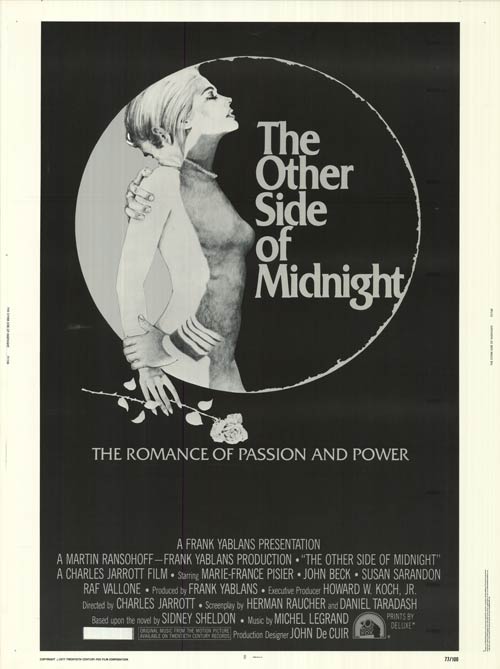The Other Side of The Other Side of Midnight

In 1973, author Sidney Sheldon published the book “The Other Side of Midnight,” a novel focusing on a love triangle between an American World War II pilot, the lover he takes while stationed in France, and the woman back home he abandons her for after the war is over. The novel, which is risqué by even today’s standards, was a smash hit at the time — it reached #1 on the New York Times Best Seller’s list that year.
Four years later, 20th Century Fox made it into a movie. The studio was following a tried-and-true recipe for success. Not only was the novel a bestseller, but the romance genre (what we may call “chick flicks” today) were generally easy wins — they were generally low budget and could fill movie theaters. Add in a cast of well-known actors into the mix, and the studio was convinced it had a winner on its hands. Movie theaters around the country agreed, and The Other Side of Midnight was scheduled for a nationwide release.
But 20th Century Fox had a problem. The studio had invested a similar amount of money to produce another movie, one that execs feared would be a bust. That movie was to come out in late May, and, to make matters worse, Universal Studios was set to release the much-anticipated Burt Reynolds film Smokey and the Bandit around the same time. (Smokey and the Bandit debuted on May 27th.) The second 20th Century Fox movie, due to weak marketing, low expectations, and strong competition, found a hard time getting onto screens — only about 40 theaters decided to show it for its May 25th release date. Fox assumed that this very limited release would doom the movie to fail, so it acted accordingly — they used The Other Side of Midnight for leverage.
In the 1930s and into the 1940s, major studios employed a strategy called “block booking,” whereby theaters would have to agree to take many of a studio’s films in order to get the right to show one highly sought-after one. In 1949, the U.S. Supreme Court barred the practice, but 20th Century Fox decided to try the gambit once more. 20th Century Fox made it clear: if a theater wanted The Other Side of Midnight for its June release, it also needed to take the other movie — a movie that Roger Ebert’s website called “a two-bit sci-fi junker.”
While this was clearly a violation of the law — in fact, 20th Century Fox found themselves on the wrong end of a lawsuit over this instance and was ordered to pay $25,000 in damages — most theaters capitulated. The sci-fi stinker only debuted at 40 theaters, but soon thereafter, many other theaters agreed to the studio’s demand, and, begrudgingly, ran the second movie to also get the rights to show The Other Side of Midnight. Within a few weeks, the second movie also got the wide release that 20th Century Fox wanted.
And that turned out to be a great move.
The Other Side of Midnight — the “sure thing,” so to speak — did fine — it grossed just under $25 million at the box on a budget of about $9 million. The less-heralded sci-fi movie, with its budget of $11 million, was expected to fail. But the studio’s ploy gave it the opportunity to reach fans across the country, and the film found an audience for itself — a huge one. It became an overnight success and grossed a then-record $775 million. And you’ve probably seen it.
It’s called Star Wars.
The success of the George Lucas film has not only led to multiple movies, TV shows, toys, and a billion other things, but it also helped create some revisionist history. By the time that $25,000 judgment came down, the world was so enamored with the Force and Jedis etc. that it became unbelievable to think Fox would have needed to bundle it with another movie, at least for R2D2’s benefit. As a result, the press typically reported the case backward. The Montreal Gazette, for example, summarized the studio’s wrongful act as “preventing movie theaters from showing its box office smash ‘Star Wars’ unless they also exhibited a less popular film.”
Bonus Fact: Most recently (as of May 3, 2021), the newest entrant to the Star Wars universe is The Mandalorian, a TV western set a long time ago in that galaxy far, far away. But in filming the show, the producers ran into a weird problem: they had more Stormtroopers than uniforms. As CBR (also known as “Comic Book Resources”) reported, “apparently, a particular scene filmed for The Mandalorian Season 1’s closing episodes required more Stormtrooper costumes than the crew had on hand.” The solution was, literally, a fan-centric one. CBR continues: “Series creator Jon Favreau and Lucasfilm’s Dave Filoni reached out to a local chapter of the 501st Legion. The 501st legion are a fan-based Star Wars organization dedicated to building and wearing screen-accurate costumes of Imperial Stormtroopers, among other villains from the franchise.” The 501 had plenty of costumes — and were invited to also participate as extras in the episode’s filming.
From the Archives: The Life and Lies of Darth Vader: What the cast knew about the surprise at the end of The Empire Strikes Back.
Take the Quiz: Name the Star Wars character by the quotes given. Includes the prequels and spelling counts.
Related: “The Other Side of Midnight,” the novel. 4.6 stars on nearly 200 reviews. Also, “The Other Side of Midnight,” the movie. 4.6 stars on just under 150 reviews. And finally, all the Star Wars movies. Review data not necessary because it’s Star Wars.
